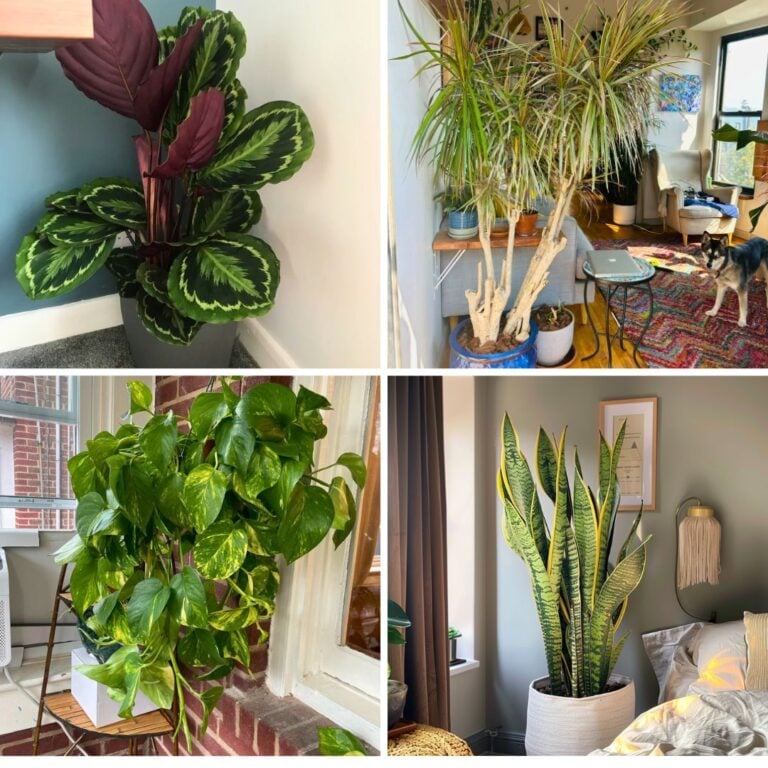15 Easy To Grow Winter Flowers You Must Grow This Year
I’m always on the lookout for ways to keep my garden lively, even when the chill sets in. Winter doesn’t have to mean empty flower beds or a dull, lifeless yard.
You can actually grow hardy flowers that bring color and energy to your garden all season. It’s easier than you might think.
Here, I’ll share 15 easy-to-grow winter flowers that can handle the cold.
You’ll see how simple it is to fill your space with blooms like pansies, hellebores, and camellias.
I’ll throw in a few care tips too, just to keep them happy through winter’s worst.
Please note: Simplify Plants is reader-supported. As an Amazon Associate, I earn from qualifying purchases made by our readers with no extra cost added to you all! Some links in the post are affiliate links and I get a commission from purchases made through links in the post.
1) Pansies

I can’t get enough of pansies in winter—they’re just so cheerful when everything else fades. Their little faces almost seem to smile back at you on gray days.
These flowers do well in cool weather and shrug off a bit of frost. I usually plant them in early fall so they have time to settle before winter really bites.
They seem to love at least six hours of sunlight daily. If the weather stays mild, they just keep blooming.
Pansies like well-drained soil that’s moist but not waterlogged. I try to keep up with watering, especially if the soil starts to dry.
Snipping off faded blooms makes a big difference. It keeps things tidy and encourages more flowers to show up.
There’s a wild range of colors—purples, yellows, whites, oranges. Mixing them up gives the garden a nice, vibrant splash.
They’re happy in pots or beds, so I sneak a few near my front door for a quick mood boost.
If it gets really cold, I toss a frost cloth over them. They usually perk right back up as soon as it warms.
A little balanced fertilizer every few weeks seems to keep them going strong.
Honestly, pansies are one of my go-to low-maintenance winter flowers—so easy, and they never fail to brighten things up.
2) Violas

I’m a big fan of violas—they’re tiny but mighty when it comes to winter color. Even when it’s chilly, they keep blooming and looking happy.
They don’t mind a bit of frost, which is perfect for the colder months.
I tuck violas into pots, window boxes, or even tiny gaps in garden beds. They don’t need much room, so you can squeeze them in almost anywhere.
I try to keep the soil moist but not soggy and make sure they catch some sunlight each day.
Cool temps actually help violas bloom longer. I notice they’re happiest between 40°F and 60°F. If it gets too warm, I’ll move the pots to a shadier spot.
They come in all sorts of colors and patterns—from soft pastels to deep purples and sunny yellows. Mixing shades adds a bit of fun to the garden.
Violas are perfect for borders or filling in spots between bigger plants.
Every few weeks, I give them a bit of balanced fertilizer. When I spot faded flowers, I just pinch them off—it’s quick and keeps things tidy.
They attract friendly pollinators like bees, even when it’s chilly. And their gentle scent is a nice surprise.
If you’re starting from seeds, I’d sow them indoors about 8 to 10 weeks before the last frost. Once they’re sturdy, just move them outside—they settle in fast.
For beginners, violas are a low-maintenance win. Colorful, hardy, and easy—what’s not to like?
3) Hellebores

I always look forward to Hellebores—they bloom when almost everything else is still sleeping. These hardy perennials often flower in late winter and stick around for weeks. Their soft pink, white, or green petals are just what my garden needs on gray days.
They’re surprisingly easy once they’re settled. Hellebores like partial shade and well-drained soil. I usually tuck them under trees or close to shrubs for a bit of wind protection.
They’re pretty low-key. I water them if it gets dry and trim away old leaves in late winter so the new growth can shine.
One bonus: deer and rabbits don’t seem interested, which saves me a headache. They’re also happy in containers, so I’ll keep one near the door for a winter pick-me-up.
Hellebores spread slowly, forming little clumps over time. Every few years, I’ll divide and replant them—easy way to share with friends or fill in shady spots.
Their long-lasting blooms and evergreen leaves keep my garden interesting, even if it snows. I never get tired of spotting their nodding flowers in the middle of winter.
4) Winter Jasmine
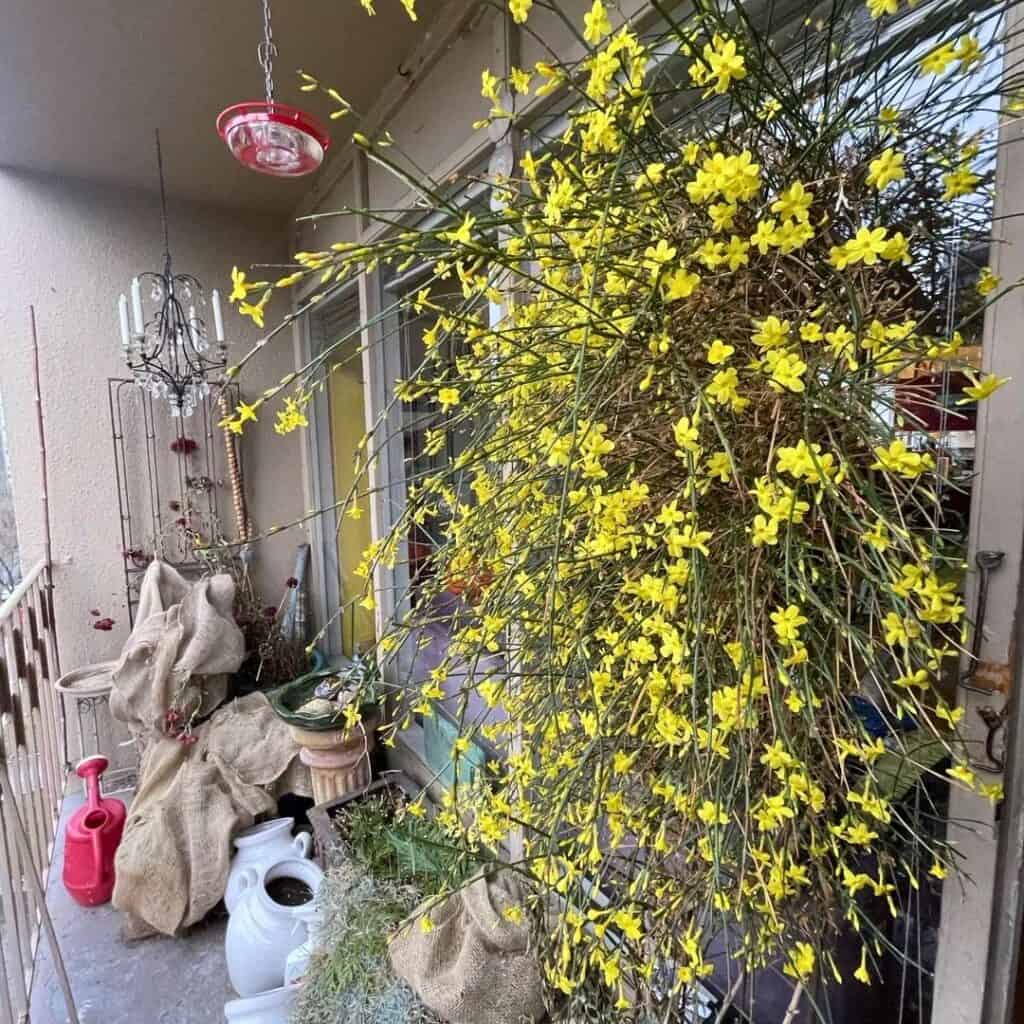
I can’t help but smile when Winter Jasmine starts blooming. Those bright yellow flowers pop in late winter, sometimes before the leaves even show up.
The blooms really stand out against bare branches and gloomy skies.
It likes full sun but will deal with partial shade. As long as the soil drains well, it’s happy—soggy roots aren’t its thing.
Once it’s settled in, Winter Jasmine can handle dry spells, which is a relief.
I usually train it to climb a fence or trellis, but if you let it go, it’ll sprawl as a shrub. A bit of pruning after flowering keeps it neat and encourages more blooms next year.
Winter Jasmine doesn’t have much scent, but its cheerful color makes up for it. I like planting it near paths or up against walls for a splash of brightness.
It’s tough—handles cold weather better than most winter flowers I’ve tried. Even after a frosty night, it bounces back.
If I want to grow it in a pot, I pick a large container with good drainage. I water when the top of the soil dries out.
I love how low-maintenance it is. Just a little trimming and watering, and it rewards me with that burst of yellow right when I need it.
5) Snowdrops
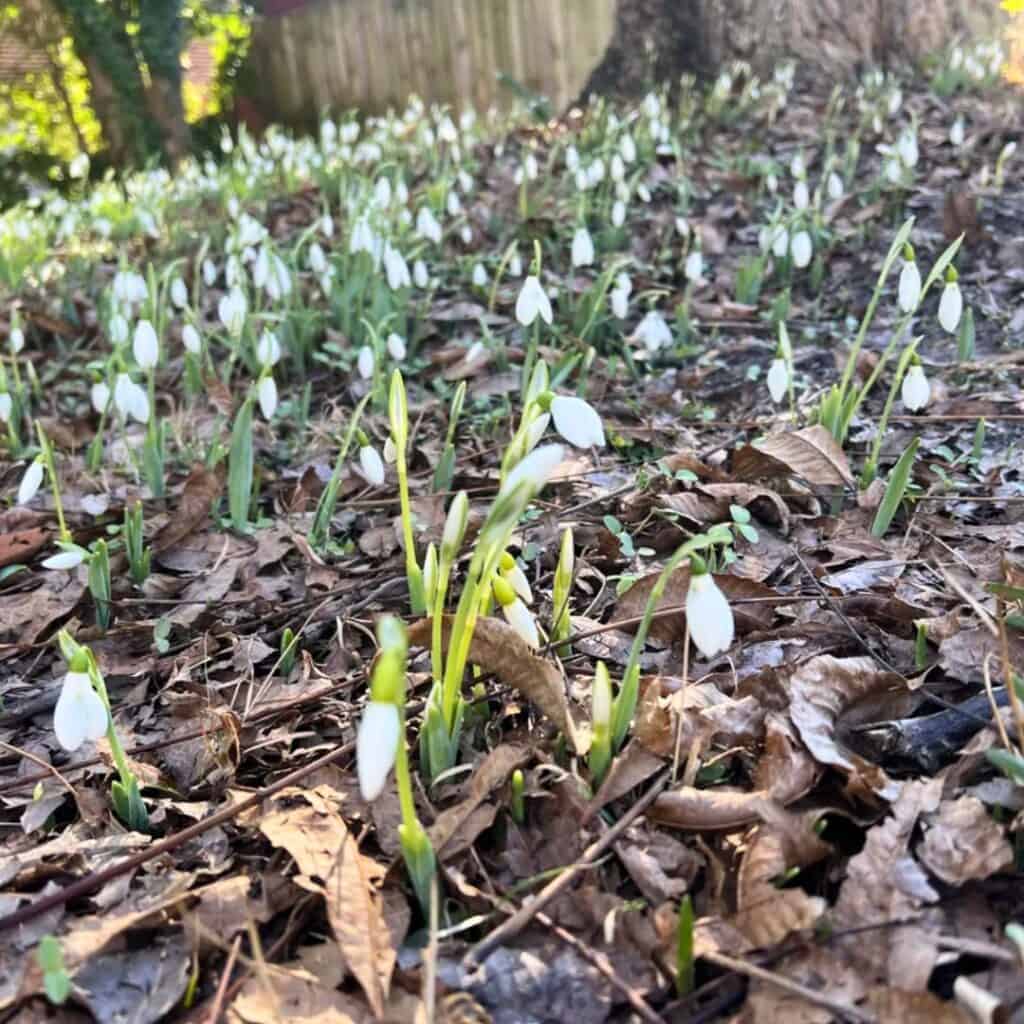
There’s something magical about Snowdrops—they’re often the first sign of life when everything else is still asleep. Sometimes they even push up through the snow, which always amazes me.
I think they’re super easy. I plant the bulbs in fall, about three inches deep, and just let them do their thing. By late winter, they’re up and blooming.
Snowdrops prefer cool, shaded spots with soil that drains well. I usually tuck them under trees or near shrubs, where the ground stays moist but not soggy.
They look their best in groups, honestly. A little cluster of Snowdrops brightens up the garden on the dullest days. Sometimes I mix them with early crocuses or winter aconites for extra color.
After blooming, I leave the leaves alone until they turn yellow. That way, the bulbs store up energy for next year.
Snowdrops don’t spread fast, but over time, you’ll get small clumps. Every few years, I dig them up and divide them to keep things healthy.
They’re about as low-maintenance as it gets. Even in tough winters, they manage to bloom. It’s a nice reminder that spring isn’t too far off.
6) Cyclamen
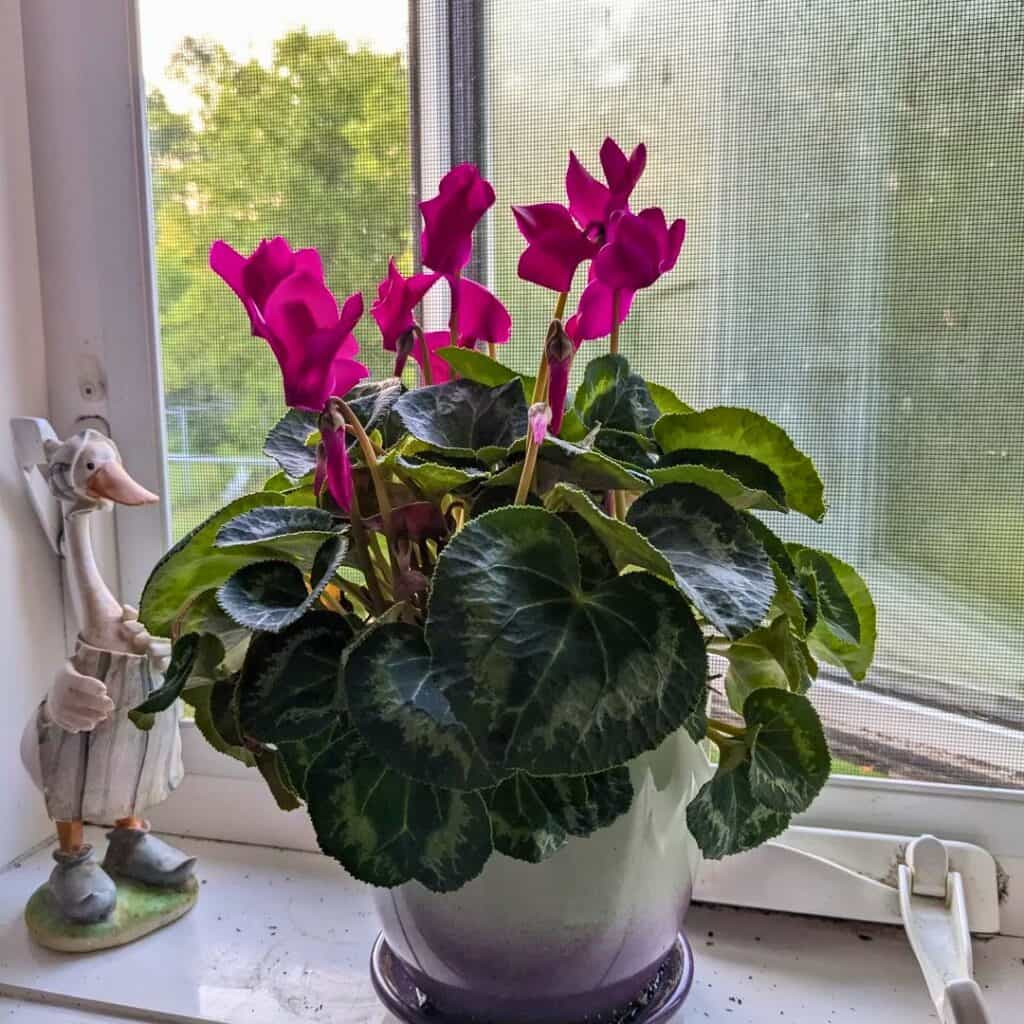
I’m always drawn to Cyclamen—they add such a pop of color indoors when everything outside looks dreary. The flowers look delicate, but they actually handle cool weather pretty well.
Their petals curl up in a way that makes them stand out from other houseplants.
I usually keep my Cyclamen in a cool, bright spot inside. They like indirect sunlight and really dislike too much heat. I’m careful with watering—just enough to keep the soil slightly moist. Too much, and the tubers could rot.
Cyclamen bloom best in winter, which is perfect for brightening up the house. The flowers come in pinks, reds, whites, and purples. Sometimes I’ll mix a few colors in one pot for extra cheer.
After the flowers fade, the leaves yellow and die back. I let the plant rest, stop watering, and keep it somewhere cool and dry. When new leaves show up, I start watering again and—like magic—it comes back.
Cyclamen make great gifts, especially around the holidays. They’re small, easy to care for, and outlast any bouquet. With a bit of attention, they’ll bloom for years.
If you’re new to Cyclamen, pick a healthy plant from a local shop. Look for firm leaves and buds that are just starting to open. Give it the right care, and you’ll have bright blooms all winter.
7) Witch Hazel

I always recommend Witch Hazel for winter color—it’s a real standout when most plants are taking a break. The bright yellow, orange, or red flowers show up in late fall and hang on through winter. Those thin, ribbon-like petals are pretty unique.
It’s a low-fuss shrub. I plant it in well-drained soil and make sure it gets some sun. Cold doesn’t seem to bother it, which is a big plus for winter gardens.
I water Witch Hazel regularly but never let it get soggy. Once it’s established, it barely needs any extra care. A light trim after flowering keeps it looking neat.
The fragrance is a nice bonus—light and sweet, just enough to notice on a cold day. I like to plant it near paths or windows so I can catch a whiff.
Witch Hazel can be a large shrub or a small tree, depending on how you prune. It works well in borders or as a single accent. In fall, the leaves turn golden before the flowers appear, so you get two shows in one.
Even in winter, I spot pollinators visiting the blooms. It’s good to know I’m helping out the local bees.
For me, Witch Hazel is a must-have for winter interest. It keeps things lively when most flowers are long gone.
8) Camellias
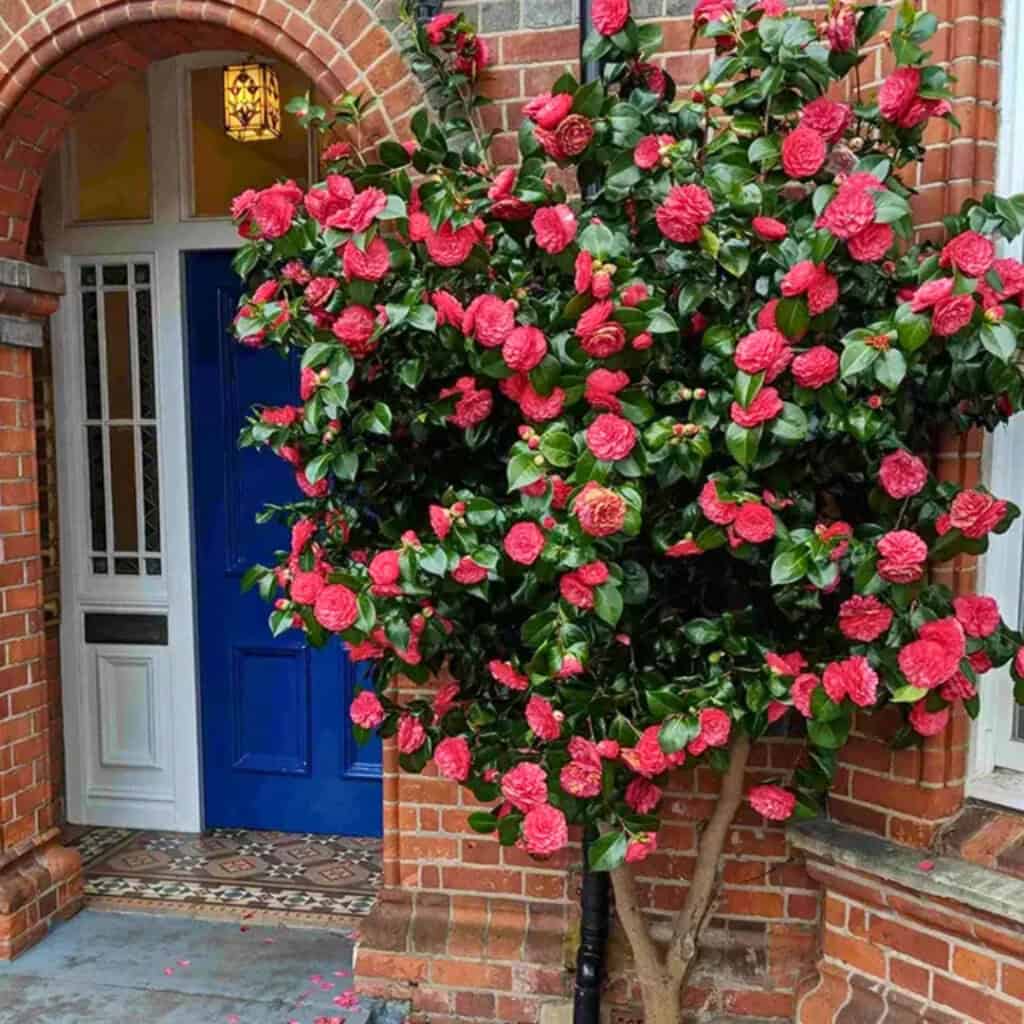
There’s something special about Camellias—they bring bright color to the garden just when I need it most. These flowers bloom from late fall through early spring, so I get cheerful blossoms for months.
Camellias like partial shade and well-drained, slightly acidic soil. I try to keep the soil moist but not soggy—too much water can be rough on their roots.
A layer of mulch around the base keeps the roots cool and helps lock in moisture. It also keeps weeds at bay, which is always nice.
If I prune lightly after flowering, Camellias stay neat and keep growing strong for the next season.
They seem to do best in sheltered spots—a wall or fence nearby helps protect the blooms from wind and frost.
Flowers come in pink, red, and white, and some have really pretty patterns. Every variety has its own charm, so it’s easy to find one that fits your style.
When those first buds open in winter, it’s a real lift. Makes me think maybe winter isn’t so bad after all.
9) Heather

I just love growing Heather in winter—it adds such a burst of color when everything else seems to fade away. Those tiny flowers in shades of pink, purple, and white really brighten up cold, dull days.
The evergreen leaves stick around, too, so my garden never looks totally bare. Heather is happiest in well-drained, acidic soil.
I always try to find a sunny spot for it, though it manages with a bit of shade now and then. Once it’s settled, Heather barely needs any attention, which is honestly perfect for those of us who get busy or a little forgetful.
At first, I water it regularly, but after it gets established, I only bother during long dry spells. Too much water can mess up the roots, so I’m careful to make sure the soil drains well.
Heather brings in bees and other pollinators even when it’s chilly, which keeps my garden lively. I really appreciate how it supports the local wildlife and still keeps things looking cheerful.
To keep it looking neat, I’ll trim it lightly after flowering. That little bit of effort goes a long way for fresh growth and a tidy look.
It’s also great in containers. I keep a couple of pots by my door for a pop of winter color, and honestly, it makes the entrance feel way more inviting, even on gray days.
Mixing Heather with winter plants like pansies or ornamental cabbage is one of my favorite tricks. The different colors and textures make everything more interesting.
Heather is tough, too—I don’t worry about frost at all. It handles cold weather better than lots of other flowers.
If you want a plant that’s easy, colorful, and doesn’t ask for much, Heather’s a fantastic pick for winter.
10) Calendula

There’s something about Calendula in winter that just lifts my mood. The orange and yellow blooms look so cheerful, even when the garden’s a bit sleepy.
I usually plant Calendula seeds in early fall, straight into the ground. They pop up quickly and don’t need much fussing over.
Calendula can handle light frost, so it’s great for cooler months. I keep the soil well-drained and just a little moist.
Too much water isn’t good for them, so I let the soil dry out a bit between waterings. A sunny spot really helps the flowers stay strong and blooming.
When I pick the flowers often, new buds keep coming. That’s a simple trick to keep the plant looking full and colorful.
Regular deadheading goes a long way for a longer blooming season. Plus, Calendula attracts beneficial insects like bees and ladybugs, which is always a win for a healthy garden.
The flowers work well as cut blooms too—I like bringing a few inside. If you start with good soil and give them sunlight, Calendulas will reward you with steady color through winter.
They’re reliable, easy, and always brighten things up.
11) Sweet Alyssum

I can’t get enough of Sweet Alyssum in winter. It adds gentle color and a sweet scent that makes my garden feel a bit magical.
The little clusters of white, pink, or purple blooms create a soft carpet, and it’s honestly lovely on those gray days. Sweet Alyssum grows best in cool weather and can take a light frost.
I plant it in well-drained soil and usually pick a sunny spot, but it’s pretty forgiving if there’s some shade. It spreads quickly and fills in gaps between other plants.
It looks great along borders, in pots, or even hanging baskets. To keep it blooming, I trim it lightly every few weeks.
That helps it stay neat and encourages new flowers. I love that it’s so low-maintenance—just a bit of water to keep the soil slightly moist.
It draws in bees and butterflies, so the garden feels more alive, even when it’s cold. If I start from seeds, they sprout fast—sometimes in just a week.
I’ll just scatter seeds in the soil and let them do their thing. Sweet Alyssum pairs well with winter flowers like pansies and violas.
The mix of colors is cheerful, especially when the weather is dreary. Since it’s compact, I can tuck it into small spaces or containers.
It’s perfect for patios or window boxes. I really do enjoy how easy and reliable Sweet Alyssum is.
It’s definitely one of my top choices for gentle color and fragrance in winter.
12) Primrose

Primroses are a favorite of mine for winter color. These little flowers bloom early and look cheerful, even when everything else is still asleep.
They come in so many colors—yellow, pink, purple, white—you name it. I like mixing them together for a soft, colorful patch.
Their compact size means I can fit them into small spots, pots, or along borders. I usually plant primroses in cool, shaded areas with some morning sun.
Too much heat makes them wilt, so I avoid direct afternoon sunlight. The soil needs to stay moist but not soggy.
I water enough to keep the ground damp, especially when the air is dry. Mulch helps hold in moisture and keeps the roots comfy.
Primroses like rich, well-drained soil, so I mix in compost before planting. It helps them stay strong and bloom longer.
Sometimes I grow them in containers by my front door. The bright blooms are a cheerful winter welcome.
When the flowers fade, I just pick off the old ones to help new buds open. If I see yellow leaves, I check for overwatering or poor drainage and fix it quickly.
I also keep an eye out for slugs—they love nibbling on the leaves. In colder areas, I protect primroses with a light layer of mulch or straw.
That keeps the roots from freezing and helps them bounce back in spring. They don’t need much fertilizer, but I’ll give them a small boost with balanced plant food once or twice during the season.
Primroses are so easy and reliable. They really do make winter gardens look alive without much work.
When the rest of the yard looks gray, primroses are still going strong.
13) Mahonia
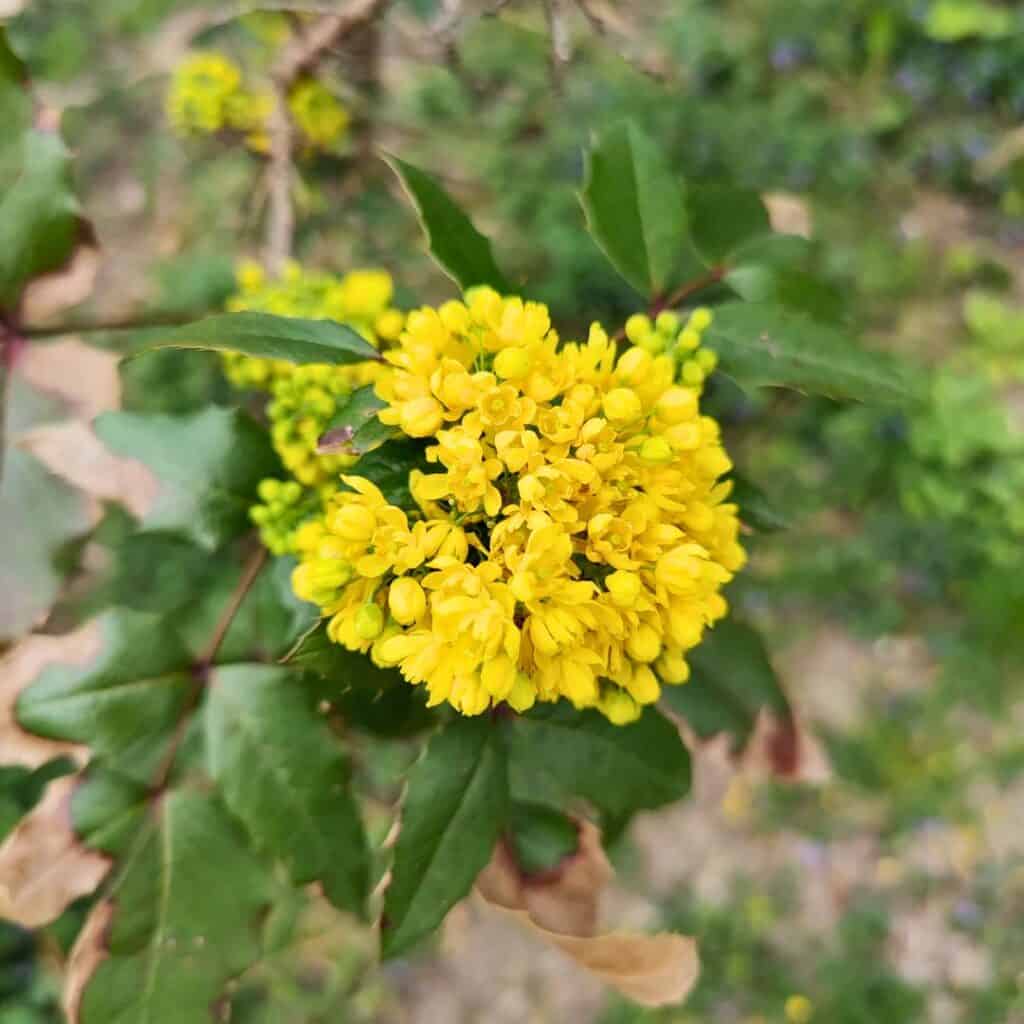
Mahonia is one of those plants that just stands out in winter. The evergreen leaves stay glossy all year, and when those bright yellow flowers show up, it’s like a little burst of sunshine.
I find Mahonia easy to grow—it really doesn’t ask for much. It handles partial shade and cold temperatures just fine.
I plant it in well-drained soil and only water when the ground feels dry. The yellow flowers turn into small blue berries that birds love.
It’s fun watching them visit during the winter. The spiky leaves are handy for borders, keeping animals out.
I prune Mahonia lightly after it finishes blooming to keep it tidy and encourage new growth. It’s a simple thing but helps the plant look healthy.
Mahonia adds structure and color when not much else is blooming. The mix of green leaves, yellow flowers, and blue berries makes it a winter favorite for me.
14) Winter Aconite

Winter Aconite is a real mood-lifter when the garden’s bleak. Those small yellow blooms pop up even with snow on the ground, which always surprises me.
I plant the bulbs in early fall so they can settle in before winter. They like cool soil and partial shade, especially under trees or shrubs.
Once they’re in, they spread slowly and form a golden carpet each year. I’ve found they do best in well-drained soil that stays a bit moist.
If the soil gets too dry, the bulbs just don’t bloom as well. I water lightly when the ground isn’t frozen to keep them healthy.
The flowers are small—maybe 3 to 4 inches tall—but they stand out against dark soil or snow. Their bright yellow petals open on sunny days and close up at night or when it’s cloudy.
Winter Aconite attracts early pollinators like bees, giving them food before anything else blooms. I love that it helps wildlife out so early in the year.
After the flowers fade, I let the leaves die back naturally so the bulbs can store energy for next year. It’s honestly one of the easiest plants to care for once it’s established.
If I want more blooms, I’ll divide the bulbs every few years in late spring when the leaves start to yellow. Replanting right away keeps them healthy.
Winter Aconite pairs nicely with snowdrops and crocuses for an early burst of color. Since it’s hardy and low-maintenance, it’s great for beginners.
I don’t have to fuss over it or worry about the cold—it just keeps coming back year after year. For me, seeing those bright yellow flowers means spring isn’t too far off.
15) Hollyhock

Hollyhock is a classic for winter, and I love how it keeps my garden lively when most plants fade away. The glossy green leaves and bright red berries are such a striking combo against the cold.
It’s tough and low-maintenance, honestly. Once it’s established, I barely have to do anything.
Hollyhock grows well in both full sun and partial shade, so I can tuck it just about anywhere. I make sure to plant both male and female Hollyhock plants—otherwise, no berries.
That one detail makes a huge difference for color. The berries attract birds, which I enjoy watching from my window.
They bring a bit of life to the garden during quiet winter months. I’ll snip a few branches for simple holiday decorations, too.
I water Hollyhock during dry spells but avoid overdoing it. It likes soil that drains well, and a layer of mulch helps protect the roots when it gets really cold.
Hollyhock grows slowly, so I just trim it lightly to keep its shape. Definitely wear gloves, though—the leaves can be sharp.
What I love most is how resilient Hollyhock is. It doesn’t mind cold, wind, or even a bit of snow.
It gives my garden structure and color when everything else looks so bare. If you’re new to winter gardening, Hollyhock is a fantastic choice.
It’s easy, beautiful, and adds a festive touch to any yard.
Winter Flower Care Tips
I keep my winter flowers going strong by focusing on healthy soil, proper watering, and frost protection. These basics really help my plants make it through the cold and keep blooming all season.
Soil Preparation for Cold Weather
I always start by loosening the soil so roots can breathe a bit easier. Compact soil can trap water, and that’s a recipe for frozen, unhappy roots.
Mixing in compost or aged manure helps with drainage and gives the soil some much-needed nutrients.
For potted flowers, I stick with a well-draining potting mix—usually something with perlite or sand tossed in. That way, the soil doesn’t get soggy and gross.
I double-check that every container has drainage holes. Root rot is the last thing anyone wants.
Before planting, I test the soil’s pH. Most winter flowers seem to prefer slightly acidic to neutral soil (pH 6.0–7.0).
If things are too acidic, I’ll add a bit of lime; too alkaline, and I’ll mix in some peat moss.
| Material | Purpose |
|---|---|
| Compost | Adds nutrients |
| Sand or Perlite | Improves drainage |
| Mulch | Keeps soil temperature steady |
A thin layer of mulch helps the soil stay warm and keeps moisture from escaping too fast.
I try to refresh the mulch every few weeks since it breaks down over time.
Watering Schedule Adjustments
Cold weather totally changes how I water. Plants just don’t need as much in winter, since the soil stays damp longer.
I poke my finger into the top inch of soil—if it’s dry, I’ll water lightly. Otherwise, I leave it alone.
Watering late in the evening? I avoid it. Morning watering gives plants time to soak up moisture before the chill sets in.
That little change seems to help keep ice from forming around the roots.
For container plants, I always make sure excess water drains out after watering. Standing water can freeze and, honestly, it’s a pain if pots crack.
I use a watering can with a narrow spout so I don’t splash leaves everywhere.
If you’re gardening in really cold places, watering even less is usually best. Overwatering is probably the main reason winter flowers don’t make it.
It’s honestly safer to keep the soil a tad dry than to let it get soggy.
Protecting Blooms from Frost
If there’s frost in the forecast, I’ll cover my flowers with frost cloths or old sheets overnight.
In the morning, I take them off so the plants can get some sun.
I move potted flowers closer to walls or tuck them under porches to shield them from cold winds.
For garden beds, mulch or straw around the base helps insulate roots.
If frost sneaks up on me, I’ll mist the plants lightly before sunrise. That thin layer of water can sometimes reduce frost damage.
I steer clear of pruning in winter since fresh cuts make plants more vulnerable to the cold.
Keeping an eye on weather changes is key. It’s wild how a few small steps can keep winter flowers looking healthy.
Benefits of Growing Winter Flowers
Honestly, I love how winter flowers keep my garden looking lively when everything else is asleep.
They bring color to those gray days and offer a bit of help to local wildlife still out and about.
Enhancing Garden Color in Winter
There’s just something about colorful blooms in the cold that lifts my mood.
Flowers like pansies, violas, and hellebores somehow stay bright even after a frost.
They fill up empty spots in the garden and make the space feel more cheerful.
I usually plant them in containers or borders near walkways so I can actually see them every day.
Their colors—purple, yellow, white, and pink—pop against bare trees and snow.
Here’s a quick list of easy choices that brighten up dull corners:
| Flower | Color Range | Light Needs |
|---|---|---|
| Pansy | Purple, yellow, white | Full sun to partial shade |
| Cyclamen | Pink, red, white | Partial shade |
| Hellebore | Cream, green, burgundy | Shade |
These plants really make my garden feel alive during the coldest months.
Supporting Pollinators During Cold Months
I still spot a few bees and butterflies wandering around on mild winter days.
By growing winter-blooming flowers, I can offer them a snack when not much else is blooming.
Hellebores, snowdrops, and winter jasmine produce nectar that helps pollinators hang in there until spring.
It’s always nice to see bees visiting these blooms, even when it’s chilly.
I skip chemicals so the flowers stay safe for insects.
Even a small patch of winter flowers can support a surprising number of pollinators and help keep things balanced in the garden.
Providing food and shelter in winter helps pollinators return stronger in spring, which means better blooms and healthier plants later.
Frequently Asked Questions
What are some low-maintenance flowers that thrive in cold weather?
I find Pansies, Violas, and Hellebores pretty easy to care for in winter.
They handle the cold well and just need regular watering and the occasional light pruning.
Can you suggest flowers that bloom in winter for a colorful garden?
Winter Jasmine and Snowdrops bring a pop of color when most plants are resting.
Their yellow and white blooms really brighten things up on gray days.
How do I protect my winter-blooming flowers from frost?
I cover plants with frost cloth or mulch when it gets cold.
That helps keep roots warm and protects delicate blooms from frost damage.
What are the best winter flowers for a sunny garden spot?
Pansies and Winter Jasmine do best in full sun.
They really thrive if they get at least six hours of light each day.
Could you recommend winter flowers that are also wildlife-friendly?
Hellebores and Snowdrops are great for attracting early pollinators like bees.
These flowers give wildlife a food source when not much else is blooming.
What soil preparation is needed for growing flowers in winter?
I usually mix in some compost before planting. It just seems to help with drainage and gives the soil a nice nutrient boost.
Loose, well-drained soil is pretty important, especially when it gets wet and cold out there. Roots just do better with a bit of breathing room, don’t you think?
Recommended Garden Supplies
| Product Image | Our Recommended Gardening Supplies | Check Offers! |
|---|---|---|
Top Top
Top
Top
Top
Top
Top
Top
Top | rePotme Houseplant and Tropical Classic Potting Soil Mix | Check Offer On Amazon |
 Top
Top
Top
Top
Top
Top
Top
Top | Espoma Organic Indoor Plant Food | Check Offer On Amazon |
 Top
Top
Top
Top
Top
Top
Top
Top | GooingTop LED Grow Light 6000K Full Spectrum Clip Plant Growing Lamp | Check Offer On Amazon |
 Top
Top
Top
Top
Top
Top
Top
Top | Soil Moisture Meter | Check Offer On Amazon |
 Top
Top
Top
Top
Top
Top
Top
Top | Govee Hygrometer Thermometer, Bluetooth Enabled! | Check Offer On Amazon |
 Top
Top | LEVOIT Humidifiers for Large Room(Best For Plants) | Check Offer On Amazon |
 Top
Top
Top
Top
Top
Top
Top
Top | Upgraded DIY Automatic Drip Irrigation Kit, 15 Potted Houseplants Support | Check Offer On Amazon |
 Top
Top
Top
Top
Top
Top
Top
Top | Stainless Steel Heavy Duty Gardening Tool Set | Check Offer On Amazon |
 Top
Top
Top
Top
Top
Top
Top
Top | Bonide Insecticidal Soap | Check Offer On Amazon |
 Top
Top
Top
Top
Top
Top
Top
Top | Bonide 32 oz Spray Neem Oil for Organic Gardening | Check Offer On Amazon |
 Top
Top
Top
Top
Top
Top
Top
Top | Garden Safe Fungicide | Check Offer On Amazon |
Note: Some images in the articles are sourced from Reddit and Other Platforms For Reference Purpose.





